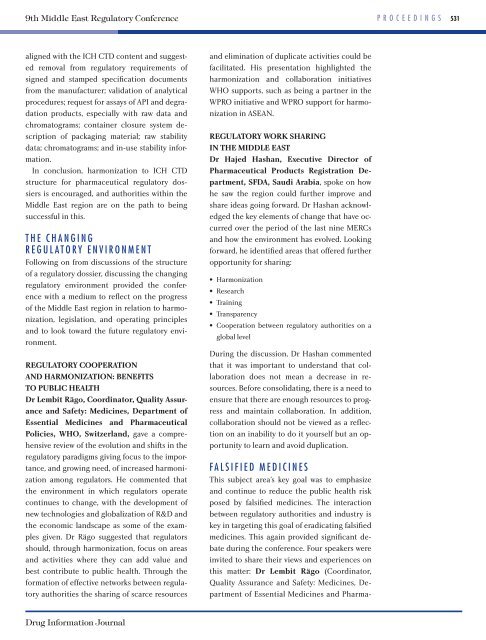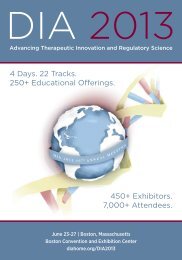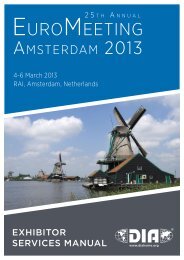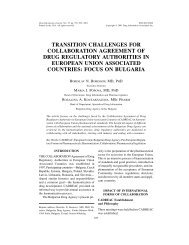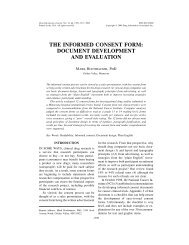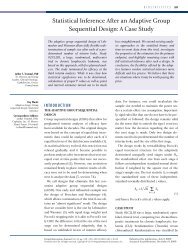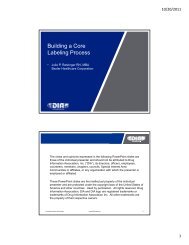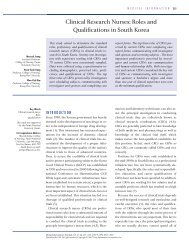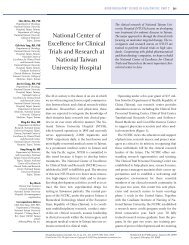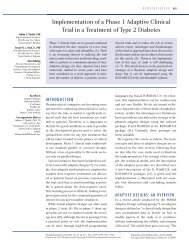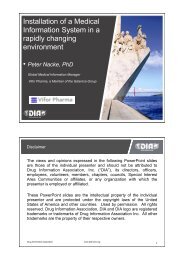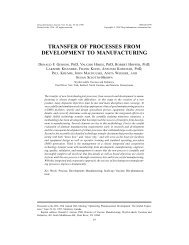Review of the 9th Middle East Regulatory Conference - Drug ...
Review of the 9th Middle East Regulatory Conference - Drug ...
Review of the 9th Middle East Regulatory Conference - Drug ...
Create successful ePaper yourself
Turn your PDF publications into a flip-book with our unique Google optimized e-Paper software.
<strong>9th</strong> <strong>Middle</strong> <strong>East</strong> <strong>Regulatory</strong> <strong>Conference</strong> p r o c e e d i n g s 531<br />
aligned with <strong>the</strong> ICH CTD content and suggested<br />
removal from regulatory requirements <strong>of</strong><br />
signed and stamped specification documents<br />
from <strong>the</strong> manufacturer; validation <strong>of</strong> analytical<br />
procedures; request for assays <strong>of</strong> API and degradation<br />
products, especially with raw data and<br />
chromatograms; container closure system description<br />
<strong>of</strong> packaging material; raw stability<br />
data; chromatograms; and inuse stability information.<br />
In conclusion, harmonization to ICH CTD<br />
structure for pharmaceutical regulatory dossiers<br />
is encouraged, and authorities within <strong>the</strong><br />
<strong>Middle</strong> <strong>East</strong> region are on <strong>the</strong> path to being<br />
successful in this.<br />
t h e c h a n g i n g<br />
r e g u L at o r y e n V i r o n m e n t<br />
Following on from discussions <strong>of</strong> <strong>the</strong> structure<br />
<strong>of</strong> a regulatory dossier, discussing <strong>the</strong> changing<br />
regulatory environment provided <strong>the</strong> conference<br />
with a medium to reflect on <strong>the</strong> progress<br />
<strong>of</strong> <strong>the</strong> <strong>Middle</strong> <strong>East</strong> region in relation to harmonization,<br />
legislation, and operating principles<br />
and to look toward <strong>the</strong> future regulatory environment.<br />
rEguLatory CooPEration<br />
and harmonization: bEnEFits<br />
to PubLiC hEaLth<br />
dr Lembit rägo, Coordinator, Quality assurance<br />
and safety: medicines, department <strong>of</strong><br />
Essential medicines and Pharmaceutical<br />
Policies, who, switzerland, gave a comprehensive<br />
review <strong>of</strong> <strong>the</strong> evolution and shifts in <strong>the</strong><br />
regulatory paradigms giving focus to <strong>the</strong> importance,<br />
and growing need, <strong>of</strong> increased harmonization<br />
among regulators. He commented that<br />
<strong>the</strong> environment in which regulators operate<br />
continues to change, with <strong>the</strong> development <strong>of</strong><br />
new technologies and globalization <strong>of</strong> R&D and<br />
<strong>the</strong> economic landscape as some <strong>of</strong> <strong>the</strong> examples<br />
given. Dr Rägo suggested that regulators<br />
should, through harmonization, focus on areas<br />
and activities where <strong>the</strong>y can add value and<br />
best contribute to public health. Through <strong>the</strong><br />
formation <strong>of</strong> effective networks between regulatory<br />
authorities <strong>the</strong> sharing <strong>of</strong> scarce resources<br />
<strong>Drug</strong> Information Journal<br />
and elimination <strong>of</strong> duplicate activities could be<br />
facilitated. His presentation highlighted <strong>the</strong><br />
harmonization and collaboration initiatives<br />
WHO supports, such as being a partner in <strong>the</strong><br />
WPRO initiative and WPRO support for harmonization<br />
in ASEAN.<br />
rEguLatory work sharing<br />
in thE middLE <strong>East</strong><br />
dr hajed hashan, Executive director <strong>of</strong><br />
Pharmaceutical Products registration department,<br />
sFda, saudi arabia, spoke on how<br />
he saw <strong>the</strong> region could fur<strong>the</strong>r improve and<br />
share ideas going forward. Dr Hashan acknowledged<br />
<strong>the</strong> key elements <strong>of</strong> change that have occurred<br />
over <strong>the</strong> period <strong>of</strong> <strong>the</strong> last nine MERCs<br />
and how <strong>the</strong> environment has evolved. Looking<br />
forward, he identified areas that <strong>of</strong>fered fur<strong>the</strong>r<br />
opportunity for sharing:<br />
• Harmonization<br />
• Research<br />
• Training<br />
• Transparency<br />
• Cooperation between regulatory authorities on a<br />
global level<br />
During <strong>the</strong> discussion, Dr Hashan commented<br />
that it was important to understand that collaboration<br />
does not mean a decrease in resources.<br />
Before consolidating, <strong>the</strong>re is a need to<br />
ensure that <strong>the</strong>re are enough resources to progress<br />
and maintain collaboration. In addition,<br />
collaboration should not be viewed as a reflection<br />
on an inability to do it yourself but an opportunity<br />
to learn and avoid duplication.<br />
fa L s i f i e d m e d i c i n e s<br />
This subject area’s key goal was to emphasize<br />
and continue to reduce <strong>the</strong> public health risk<br />
posed by falsified medicines. The interaction<br />
between regulatory authorities and industry is<br />
key in targeting this goal <strong>of</strong> eradicating falsified<br />
medicines. This again provided significant debate<br />
during <strong>the</strong> conference. Four speakers were<br />
invited to share <strong>the</strong>ir views and experiences on<br />
this matter: dr Lembit rägo (Coordinator,<br />
Quality Assurance and Safety: Medicines, Department<br />
<strong>of</strong> Essential Medicines and Pharma


